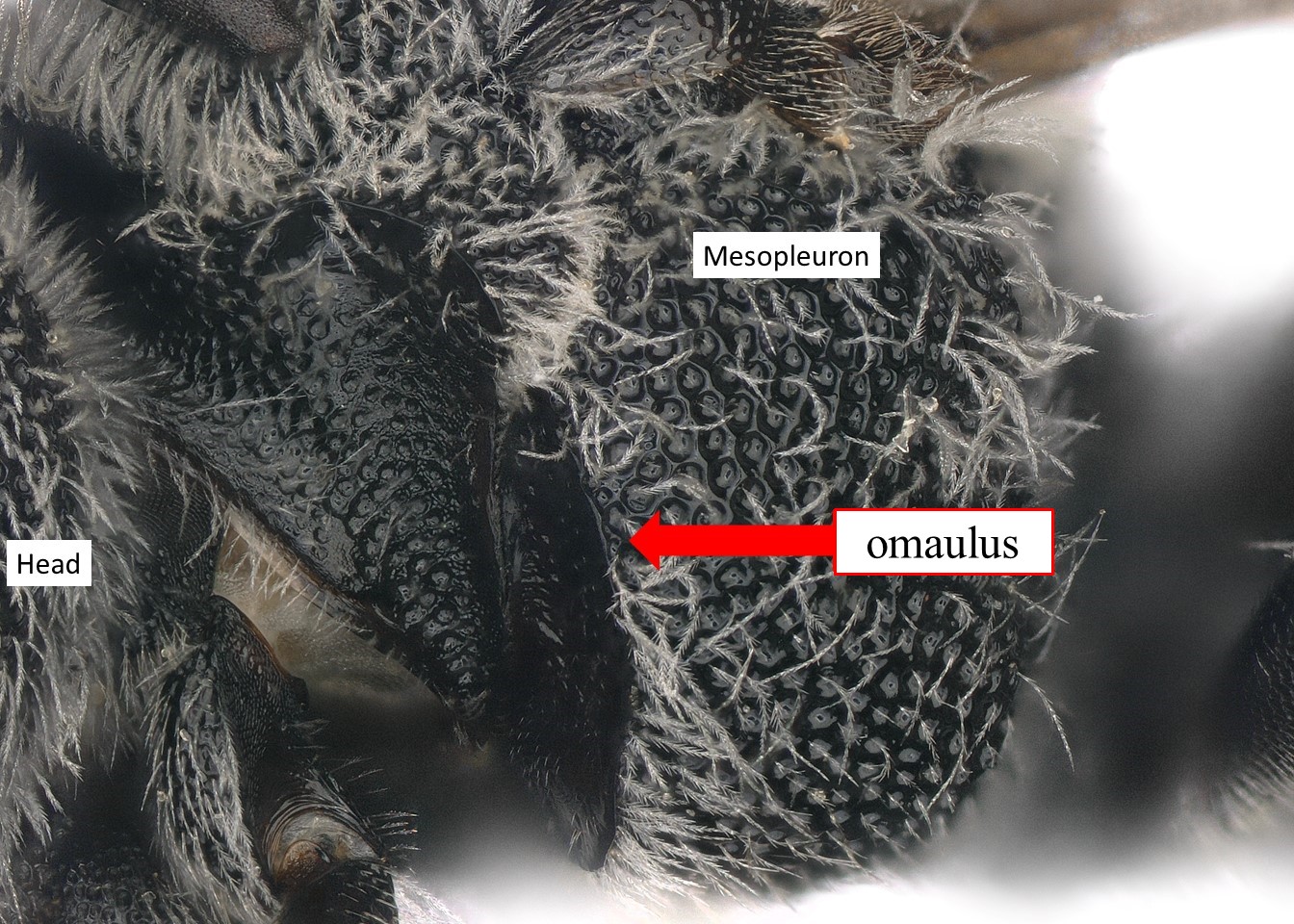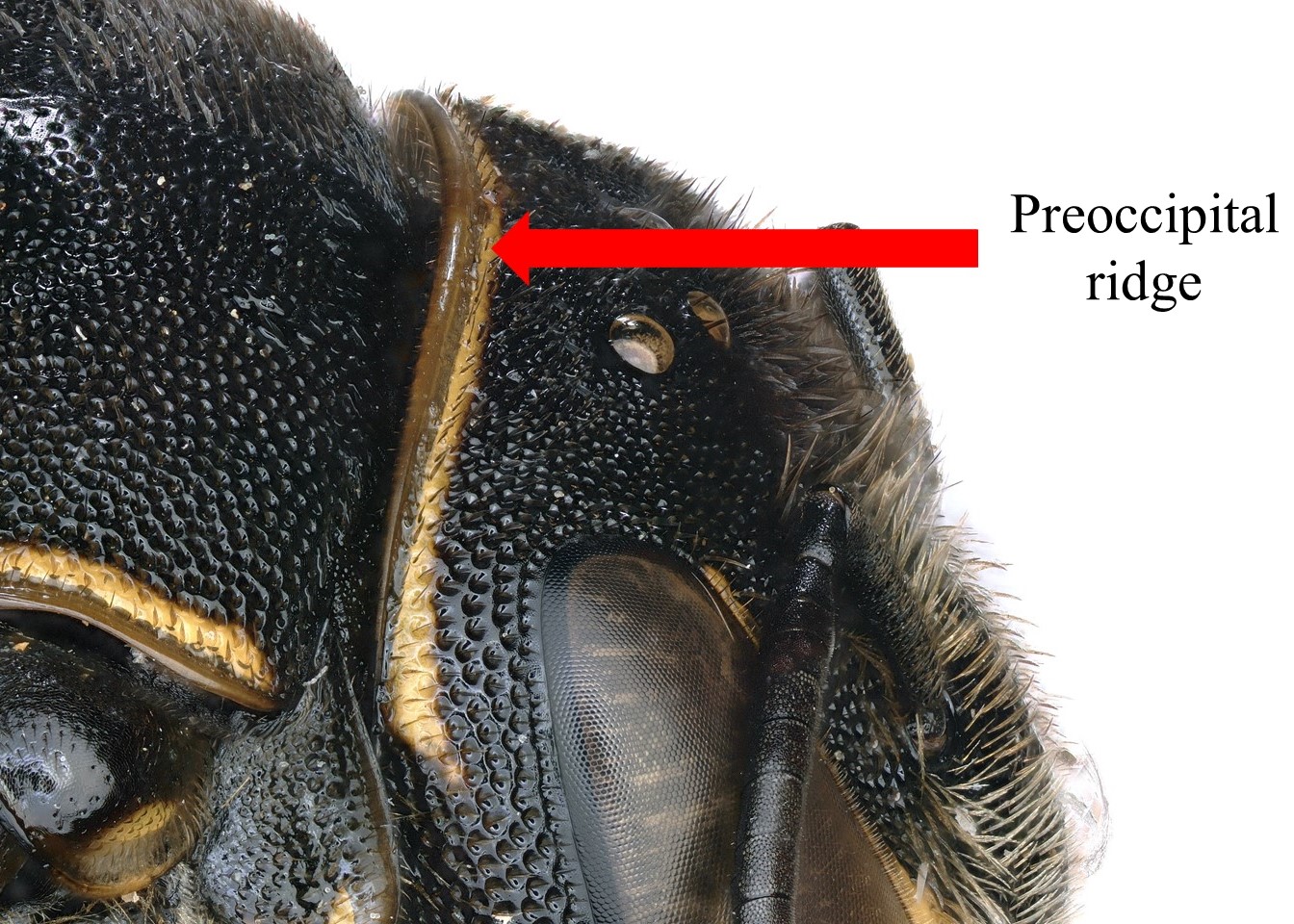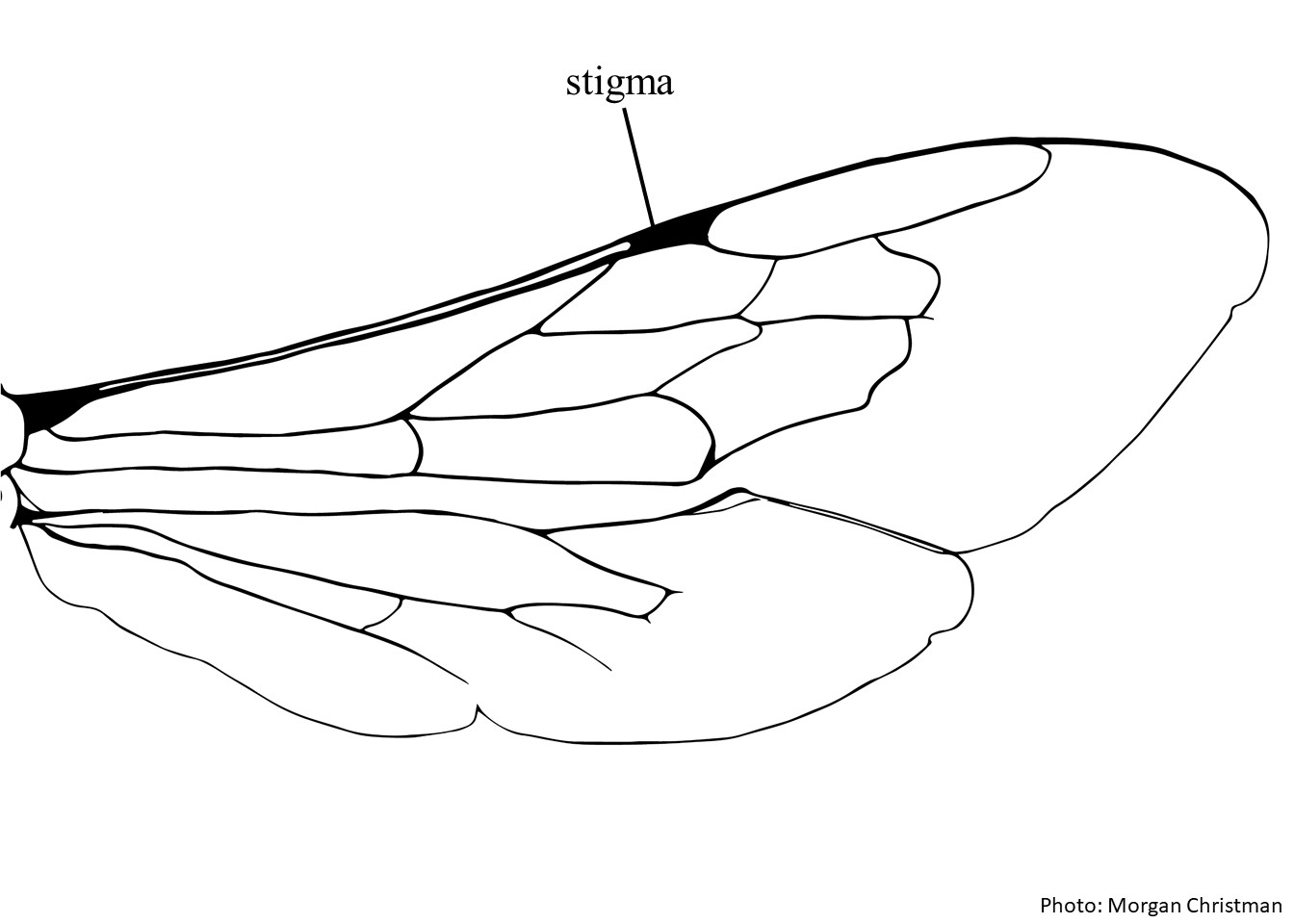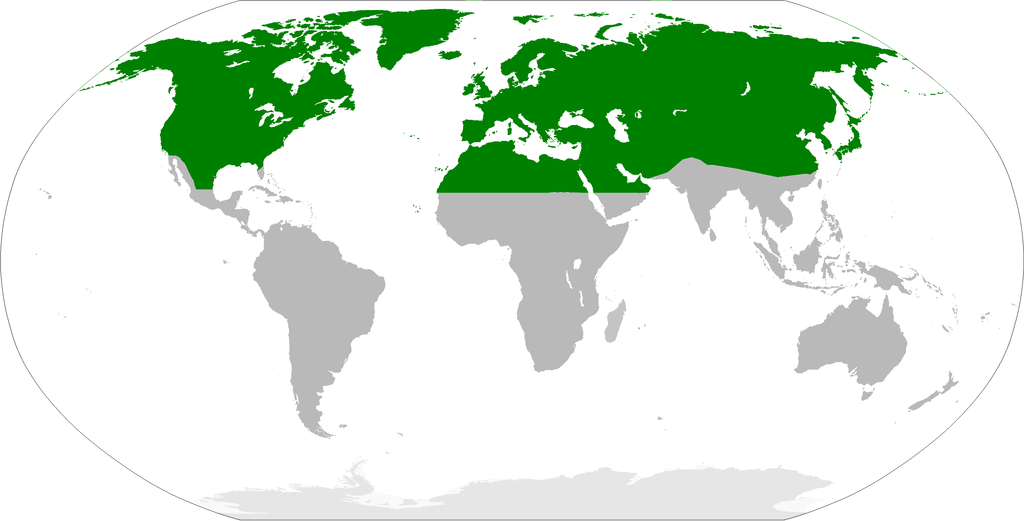Family: Megachilidae
Subfamily: Megachilinae
Tribe: Anthidiini
Genus: Stelis Panzer, 1806
Subgenera: Dolichostelis, Heterostelis, Malanthidium, Protostelis, Pseudostelis, Stelidomorpha, Stelis
Common name: cuckoo bees
Stelis are cleptoparasiticcleptoparasitic:
bees that lay their eggs in the nest cells of bees in other genera. Their larvae depend on the pollen provided by their host. Since cleptoparasitic bees don't provision their own nests, and instead depend on the pollen collected by their host, the females lack pollen collecting hairs. This often gives them a wasp-like appearance.
bees, ranging from metallic blue or green to black in color (Michener 2007Michener 2007:
Michener, C.D. 2007. The Bees of the World (2nd ed.). Johns Hopkins University Press, Baltimore and London, 953 pp.). They may sometimes have contrasting orange, yellow, cream, or white-colored maculations to the abdomen and thorax (Michener 2007Michener 2007:
Michener, C.D. 2007. The Bees of the World (2nd ed.). Johns Hopkins University Press, Baltimore and London, 953 pp.). They are generally stout-bodied and range in body length from 3–14 mm. Females do not gather pollen and lack scopae (Michener 2007Michener 2007:
Michener, C.D. 2007. The Bees of the World (2nd ed.). Johns Hopkins University Press, Baltimore and London, 953 pp.).
Stelis contains 100+ species in 7 subgenera worldwide; 51 species in 3 subgenera are known to occur in the U.S. and Canada (Wilson and Carril 2016Wilson and Carril 2016:
Wilson, J.S. and O.M. Carril. 2016. The Bees in Your Backyard: A Guide to North Americarsquo;s Bees. Princeton University Press, Princeton and Oxford, 288 pp.).
(modified from Michener 2007Michener 2007:
Michener, C.D. 2007. The Bees of the World (2nd ed.). Johns Hopkins University Press, Baltimore and London, 953 pp.)
 rounded or weakly carinatecarinate:
rounded or weakly carinatecarinate: rounded, or sometimes weakly carinatecarinate:
rounded, or sometimes weakly carinatecarinate: less than twice as long as broad.
less than twice as long as broad. with mid apicalapical:
with mid apicalapical: rounded, weakly bilobed or weakly trilobed.
rounded, weakly bilobed or weakly trilobed.Stelis can often look very similar to their hosts. Some have yellow bandsbands:
usually referring to bands of hair or bands of color that traverse across an abdominal segment
like many anthidiines, while others are solid blue and look very similar to Osmia. Others may be quite small and black like Ashmeadiella (Michener 2007Michener 2007:
Michener, C.D. 2007. The Bees of the World (2nd ed.). Johns Hopkins University Press, Baltimore and London, 953 pp.). They can be differentiated by the diagnostic characteristics listed above.
There are no known invasives.
Females do not gather pollen from flowers, since the larvaelarvae:
active immature form of an insect, especially one that differs greatly from the adult and forms the stage between egg and pupa
develop cleptoparasitically on their host’s pollen provisions (Michener 2007Michener 2007:
Michener, C.D. 2007. The Bees of the World (2nd ed.). Johns Hopkins University Press, Baltimore and London, 953 pp.). A variety of flowers are used for nectar and nesting resin (Parker et al. 1987Parker et al. 1987:
Parker, F.D., J.H. Cane, G.W. Frankie, and S.B. Vinson. 1987. Host records and nest entry by Dolichostelis , a kleptoparasitic anthidiine bee. Pan-Pacific Entomologist 63: 172ndash;177.).
These are one of the various groups of solitary brood parasites collectively referred to as “cuckoo bees.” Stelis are cleptoparasiticcleptoparasitic:
bees that lay their eggs in the nest cells of bees in other genera. Their larvae depend on the pollen provided by their host. Since cleptoparasitic bees don't provision their own nests, and instead depend on the pollen collected by their host, the females lack pollen collecting hairs. This often gives them a wasp-like appearance.
on a wide range of other megachilid bees (Parker et al. 1987Parker et al. 1987:
Parker, F.D., J.H. Cane, G.W. Frankie, and S.B. Vinson. 1987. Host records and nest entry by Dolichostelis , a kleptoparasitic anthidiine bee. Pan-Pacific Entomologist 63: 172ndash;177.; Wilson and Carril 2016Wilson and Carril 2016:
Wilson, J.S. and O.M. Carril. 2016. The Bees in Your Backyard: A Guide to North Americarsquo;s Bees. Princeton University Press, Princeton and Oxford, 288 pp.). Some groups may specialize on a limited range of hosts, such as the subgenus Heterostelis, which parasitizes Trachusa spp. (Michener 2007Michener 2007:
Michener, C.D. 2007. The Bees of the World (2nd ed.). Johns Hopkins University Press, Baltimore and London, 953 pp.). Eggs are laid inside the host’s nest cell as the female is provisioning the nest (Michener 2007Michener 2007:
Michener, C.D. 2007. The Bees of the World (2nd ed.). Johns Hopkins University Press, Baltimore and London, 953 pp.). The pharatepharate:
in transition between stages of development
1st instar larvalarva:
active immature form of an insect, especially one that differs greatly from the adult and forms the stage between egg and pupa
undergoes its first molt while still inside the egg. Sometime after eclosioneclosion:
the act of emerging from the pupal case or hatching from the egg
, the larvaelarvae:
active immature form of an insect, especially one that differs greatly from the adult and forms the stage between egg and pupa
will use their robust pointed mandibles to destroy the host egg or larvalarva:
active immature form of an insect, especially one that differs greatly from the adult and forms the stage between egg and pupa
and feed on the pollen stores of its host (Michener 1955Michener 1955:
Michener, C.D. 1955. Some biological observations on Hoplitis pilosifrons and Stelis lateralis (Hymenoptera, Megachilidae). Journal of the Kansas Entomological Society 283: 81ndash;87.). In some Stelis, like subgenus Dolichostelis, the female parasite destroys the Megachile sp. host egg before oviposition (Michener 2007Michener 2007:
Michener, C.D. 2007. The Bees of the World (2nd ed.). Johns Hopkins University Press, Baltimore and London, 953 pp.).
Stelis is a large genus of bees that occur primarily in the HolarcticHolarctic:
biogeographic region that encompasses the majority of habitats found throughout the northern continents of the world , with a few members found in warmer climates such as Costa Rica, Malaysia, Kenya, and South Africa (Michener 2007Michener 2007:
, with a few members found in warmer climates such as Costa Rica, Malaysia, Kenya, and South Africa (Michener 2007Michener 2007:
Michener, C.D. 2007. The Bees of the World (2nd ed.). Johns Hopkins University Press, Baltimore and London, 953 pp.). They are transcontinentally distributed in the U.S. and Canada and are even found at latitudes above the Arctic Circle (Michener 2007Michener 2007:
Michener, C.D. 2007. The Bees of the World (2nd ed.). Johns Hopkins University Press, Baltimore and London, 953 pp.; Wilson and Carril 2016Wilson and Carril 2016:
Wilson, J.S. and O.M. Carril. 2016. The Bees in Your Backyard: A Guide to North Americarsquo;s Bees. Princeton University Press, Princeton and Oxford, 288 pp.).
Distribution map generated by Discover Life -- click on map for details, credits, and terms of use.
Michener, C.D. 1955. Some biological observations on Hoplitis pilosifrons and Stelis lateralis (Hymenoptera, Megachilidae). Journal of the Kansas Entomological Society 283:81-87.
Michener, C.D. 2007. The Bees of the World (2nd ed.). Johns Hopkins University Press, Baltimore and London, 953 pp.
Parker, F.D., J.H. Cane, G.W. Frankie, and S.B. Vinson. 1987. Host records and nest entry by Dolichostelis, a kleptoparasitickleptoparasitic:
bees that lay their eggs in the nest cells of bees in other genera. Their larvae depend on the pollen provided by their host. Since cleptoparasitic bees don't provision their own nests, and instead depend on the pollen collected by their host, the females lack pollen collecting hairs. This often gives them a wasp-like appearance.
anthidiine bee. Pan-Pacific Entomologist 63:172-177.
Wilson, J.S. and O.M. Carril. 2016. The Bees in Your Backyard: A Guide to North America’s Bees. Princeton University Press, Princeton and Oxford, 288 pp.